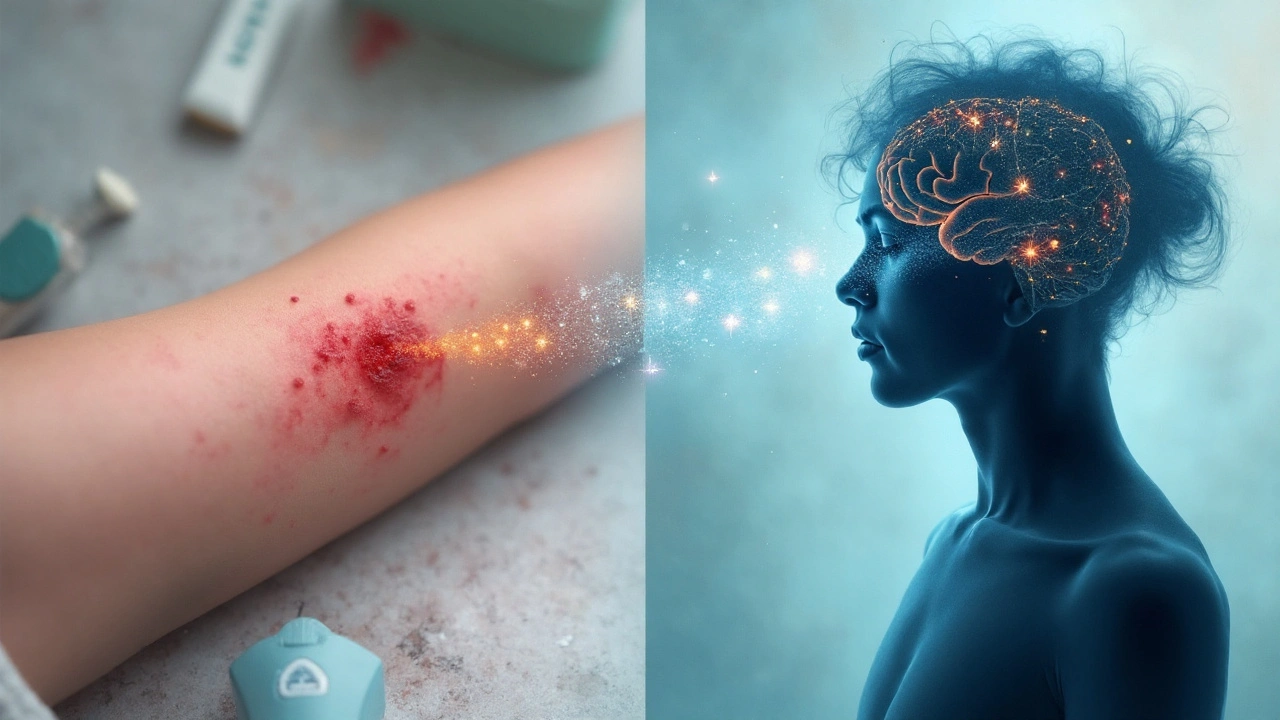Psychogenic itch is a type of pruritus that originates from psychological stress rather than a visible skin disorder. It often shows up as an annoying, persistent sensation without rash, and it can snowball when anxiety fuels more scratching.
Why Stress Turns Into an Itch
When you’re under pressure, the brain releases cortisol the primary stress hormone. Cortisol spikes change how nerve endings in the skin respond, making them hyper‑sensitive to even mild stimuli. At the same time, the limbic system ups the production of serotonin a neurotransmitter that modulates mood and sensation, which can amplify the perception of itch. The combination creates a feedback loop: stress raises cortisol, cortisol sensitises nerves, the itch sensation grows, and the urge to scratch spikes anxiety further.
Key Biological Players
Besides cortisol and serotonin, two other molecules often join the party:
- Histamine an immune‑derived chemical that typically triggers allergic itch. In psychogenic itch, histamine levels can be normal, but the brain’s heightened alertness makes even baseline histamine feel intense.
- SubstanceP a neuropeptide that transmits pain and itch signals. Stress can boost SubstanceP release, further priming the skin’s itch pathways.
The skin barrier itself also plays a role. Chronic stress weakens the stratum corneum, allowing irritants to slip through and provoke itching even when no allergy is present.
How Psychogenic Itch Differs From Other Types
Doctors sort itch into three broad buckets:
- Histamine‑mediated itch (e.g., hives, insect bites).
- Neuropathic itch (damage to nerves, such as shingles).
- Psychogenic itch - the stress‑related variety.
While histamine‑driven itch often responds to antihistamines, and neuropathic itch may need nerve‑targeting drugs, psychogenic itch usually needs a mental‑health‑first approach.
| Attribute | Histamine‑Mediated | Neuropathic | Psychogenic |
|---|---|---|---|
| Typical Trigger | Allergens, insect bites | Nerve injury, shingles | Stress, anxiety, emotional upset |
| Skin Appearance | Red, wheal, hives | Often normal or scarred | Usually no visible lesions |
| Effective Medication | Antihistamines | Gabapentin, pregabalin | CBT, mindfulness, stress‑reduction |
| Key Biomarkers | Elevated histamine levels | Altered nerve conduction | High cortisol, altered serotonin |
Diagnosing Psychogenic Itch
Because the skin often looks normal, clinicians rely on a detailed history. They ask about recent life events, sleep quality, and any co‑existing anxiety or depression. A Dermatology medical specialty focused on skin health exam will rule out rashes, while a brief Psychodermatology field that bridges mental health and skin disorders assessment looks for stress‑related patterns. Laboratory tests (e.g., serum histamine) are usually normal, reinforcing the psychological origin.

Managing the Itch‑Stress Cycle
Breaking the loop requires tackling both mind and body. Below are evidence‑based tactics that work together.
- Cognitive‑behavioral therapy (CBT) a structured psychotherapy that reshapes negative thought patterns. CBT teaches patients to recognise stress cues and replace scratching with healthier coping strategies.
- Mindfulness meditation a practice that anchors attention to the present moment. Studies show a 30‑45% reduction in itch intensity after eight weeks of daily sessions.
- Topical moisturisers to restore the skin barrier, reducing peripheral irritants that can worsen the sensation.
- Regular aerobic exercise, which lowers cortisol baseline and boosts endorphins, naturally dampening itch signals.
- Sleep hygiene - a consistent bedtime routine keeps cortisol swings in check, limiting nocturnal scratching bouts.
When psychological methods aren’t enough, short courses of low‑dose antihistamines can provide temporary relief, but they are adjuncts rather than primary treatment.
Real‑World Example: Jane’s Story
Jane, a 34‑year‑old marketing manager in Birmingham, began noticing an “invisible” itch during tight project deadlines. Her dermatologist found no rash, but a brief questionnaire revealed high perceived stress and frequent night‑time rumination. After eight weeks of weekly CBT sessions, combined with daily 10‑minute mindfulness and a simple skin‑care routine, Jane reported a 70% drop in itch frequency. Her sleep improved, and she no longer felt the urge to scratch at work, demonstrating how interdisciplinary care can restore comfort.
Related Concepts and Next Steps
Understanding psychogenic itch opens doors to other mind‑skin topics:
- Dermatologic conditions aggravated by stress eg, eczema, psoriasis, rosacea
- Neuro‑immune communication the two‑way dialogue between nerves and immune cells
- Stress reduction techniques such as progressive muscle relaxation or yoga
Readers interested in deeper dives might explore “stress‑related eczema management” or “the role of serotonin in chronic itch”. Those with persistent symptoms should book an appointment with a dermatologist who collaborates with a psychologist - the ideal psychodermatology team.
Frequently Asked Questions
Can stress really cause an itch without a rash?
Yes. Stress triggers hormonal and neurochemical changes that heighten nerve sensitivity, leading to a sensation of itch even when the skin looks normal. This is the hallmark of psychogenic itch.
How is psychogenic itch diagnosed?
Doctors start with a full skin exam to exclude visible conditions, then take a detailed psychosocial history. Normal lab results (e.g., histamine levels) alongside high stress scores point to a psychogenic origin.
Are antihistamines effective for stress‑related itch?
They may offer mild, temporary relief, but they don’t address the underlying stress. Long‑term control relies on psychological interventions and skin‑care strategies.
What role does cortisol play in the itch‑stress cycle?
Cortisol spikes heighten the excitability of peripheral nerve endings, making them react to minor stimuli. Persistent elevation keeps the itch signal constantly “on”.
Can CBT actually reduce the sensation of itch?
Clinical trials show CBT reduces itch intensity by up to 40% by teaching patients to break the stress‑scratching feedback loop and reframe anxiety triggers.
Is there a quick self‑help tip for an acute itch episode?
Try the 4‑7‑8 breathing technique for one minute while gently applying a fragrance‑free moisturizer. This lowers heart rate, reduces cortisol, and soothes nerve endings.


16 Responses
I used to scratch my arms like crazy during deadlines until I started using that 4-7-8 breathing trick. No joke, it works. My skin stopped looking like a battlefield.
Also moisturizer. Don't sleep on moisturizer.
So let me get this straight - your brain is just making up itching now? Like, if I stress hard enough, can I make my cat itch too? This is just anxiety dressed up in medical jargon.
This is the most real thing I've read all week. I didn't know my 3am scratching was stress-related. I thought I had eczema. Turns out I just needed to stop doomscrolling before bed. CBT changed my life. Also, I started walking 20 minutes a day. No meds. Just movement and breath. My skin is finally calm.
The science here is solid. Cortisol dysregulation directly impacts TRPV1 receptors in the skin, lowering the threshold for itch perception. Serotonin’s role in central sensitization is well-documented in chronic pruritus literature. This isn't 'just in your head' - it's in your neurobiology. And yes, CBT rewires the limbic response over time. Evidence-based. No fluff.
OMG YES. I’ve been dealing with this for years and felt so alone. I thought I was just ‘weird’ for itching when nothing was there. I started doing yoga and now I keep a little lavender lotion by my desk. It’s not magic, but it’s mine. Thank you for writing this.
Ah yes, the latest wellness cult: ‘I itch because my aura is unbalanced.’ Next they’ll say your sneezes are caused by unresolved childhood trauma. Antihistamines are $5. Therapy is $200/hour. Guess which one Big Pharma wants you to buy? 😏
This is why America is falling apart. People can’t even handle a little stress anymore. Back in my day, we just ignored itches. We didn’t need a 12-step program to stop scratching. Just toughen up. Maybe if you stopped eating gluten and watching TikTok, your skin would heal.
In India we call this 'dil ki chinta' - worry from the heart. My grandma used to say, 'If your skin itches, check your thoughts.' She never heard of cortisol, but she knew the truth. CBT? We just called it 'thinking better.' Simple. Effective.
So the medical establishment has officially run out of actual diseases to diagnose, and now they’re turning normal human discomfort into psychiatric disorders? Brilliant. Next they’ll classify being tired as ‘chronic existential pruritus.’
I just don’t get why people make this so complicated. You’re stressed. You itch. You stop being stressed. You stop itching. Done. Why do we need all these fancy words and charts? Just chill out. It’s not rocket science.
For those curious about the neuroimmune axis: mast cells express CRF receptors, which bind cortisol and degranulate in response to psychological stressors, releasing histamine and TNF-alpha locally - even without systemic elevation. That’s why skin looks normal but feels like hell. The barrier dysfunction is measurable via TEWL (transepidermal water loss). CBT reduces IL-6 and substance P in CSF. It’s not placebo. It’s physiology.
i never knew stress could do this. i thought i was just bad at taking care of my skin. i started using cerave and now i dont scratch as much. also i sleep better. thanks for the post lol
I want to add something important: sleep hygiene isn’t just about bedtime - it’s about reducing blue light exposure, avoiding caffeine after 2 PM, and keeping your room cool. I used to think I was ‘just a night owl,’ but my cortisol was spiking at 3 AM, triggering scratching. Once I fixed my sleep architecture, the itch dropped by 60% in two weeks. Consistency > intensity.
I'm from India and I've seen this in my family for years. My mom would say, 'Don't scratch, it's your mind playing tricks.' She didn't know the science, but she knew the truth. Now I use aloe vera gel and breathe before I scratch. It helps. 🌿❤️
I tried CBT and honestly? It felt weird at first. Like talking to a robot about my anxiety. But after a few weeks, I started catching myself before I scratched. Now I pinch my arm instead. Weird, but it works. Also, I started journaling. Writing down what stressed me out made it feel smaller.
I’m a nurse and I’ve seen this so many times. Patients come in with perfect skin, scratching like their life depends on it. We used to dismiss them. Now we ask, ‘What’s going on in your life?’ Nine times out of ten, it’s divorce, job loss, grief. This isn’t ‘just stress’ - it’s trauma speaking through skin. We need more psychodermatology clinics. Please, someone fund them.